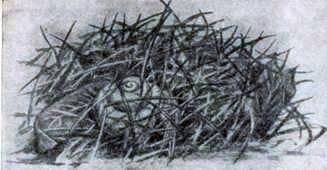
But, perhaps, the most amazing nests are arranged by a bee – a mason. She looks for an empty shell for each egg, brings her fodder dough to the depths for the larva and lays an egg on it.

Fig.107. The nest of a bee is a mason in the empty shell of a snail. лФ – fodder dough; I am the egg; л – the chamber filled with air; Pl – partitions from chewed leaves; Km – pebbles (doubled).
At some distance from the egg, she builds a transverse septum of chewed leaves and clogs the rest of the spiral passage inside the shell with small stones, fixing them with a second transverse wall of chewed leaves. But this also seems to her insufficient to protect her offspring, which is subject to the persecution of numerous enemies. She spares no effort, she drags a straw after a straw and builds a hut out of dry grass, thin dry twigs or needle needles, under which the lodge is completely hidden.

Fig. 108. A shell with a bee egg is hidden by a hut from stalks.
Ускоренное размножение. Термокамера для пчел.
Breeds of bees